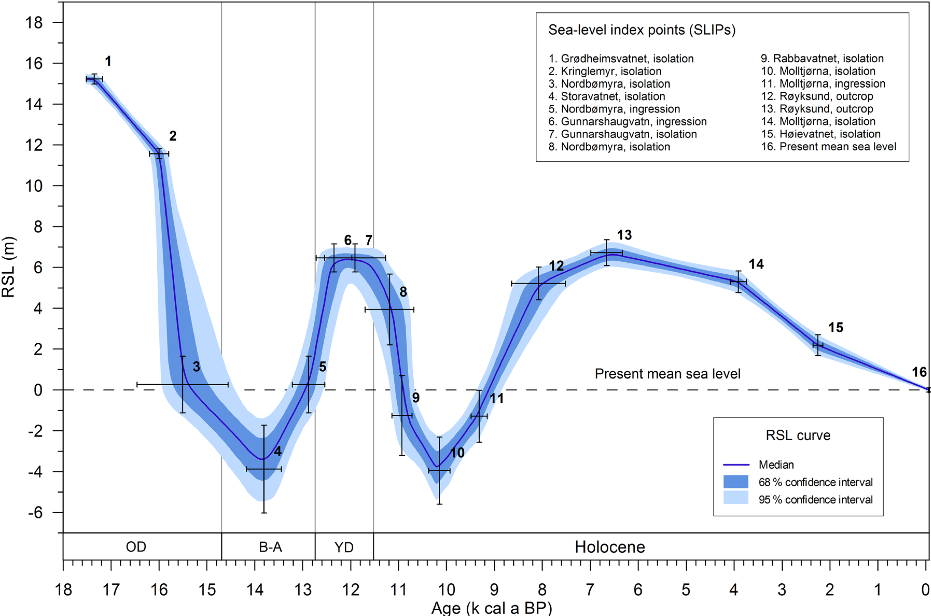Written by Kristian Vasskog, associate professor at the Bjerknes Centre for Climate Research and the Department of Geography at the University of Bergen
During a coring campaign in the fall of 2014 we discovered marine sediments at the bottom of a bog called Kringlemyr near the southern tip of Karmøy in Rogaland (see map above). In itself, this might not seem very surprising, as the Norwegian coastal landscape is dotted with lakes and bogs that have previously been submerged below sea level. We call these unique sedimentary archives ‘isolation basins’, as they have at some point in the past been submerged below sea level before being isolated from the sea due to glacial isostatic uplift.
For most of Norway, the total postglacial uplift has been larger than the global sea-level rise over the same period, giving us marine limits (the highest recorded relative sea level following deglaciation) ranging from a few meters above present sea level at the outer coast, to over 200 meters in the inner fjord regions.

Here we return to the one thing that was surprising about our newly discovered isolation basin Kringlemyr: it was situated several meters above the marine limit established by previous research for the Boknafjorden region. Finding marine deposits at this altitude should therefore be impossible. This conundrum prompted further investigations on southern Karmøy, and through the work of master students Eva Maria Lunnan and Arve Svean, the known sea-level history for the outer west coast of Norway was expanded three thousand years further back in time.
It turned out that the only reasonable explanation for the high marine limit on southern Karmøy, was that deglaciation occurred much earlier here than in closely adjacent areas, probably in relation to the initial break-up of the ice stream that occupied the Norwegian Channel (map above) during the Last Glacial Maximum. Through radiocarbon dating of small, single-celled organisms known as foraminifera from the basal sediments of the investigated isolation basins, we found that southern Karmøy became ice-free around 18 thousand years before present (ka BP).
This means that as isostatic uplift commenced, relative sea level fell several meters on southern Karmøy while northern Karmøy and other adjacent areas were still covered by ice. Thus, the marine limit on southern Karmøy, which we estimate to be 16-19 m above present sea level, is both higher and older than the shoreline corresponding to the marine limit in the northern part of the island.
Following deglaciation at 18 ka BP, sea level on Karmøy has fluctuated up and down several times, with two separate minima well below present sea level and two separate maxima about 5-7 m above present sea level, as seen in the graph below. This variability is mainly due to a tug of war between global sea-level rise on one side and local isostatic uplift on the other, although changes in gravitational attraction from the Scandinavian ice sheet played a major role in the earliest period.
In fact, modelling suggests that sea level would have been 20 m lower (about the same as present) at the time of deglaciation if not for the gravitational attraction the ice sheet had on the ocean masses. This means that the total land uplift on southern Karmøy has been more-or-less equal to the ~120 m of global sea-level rise over the course of the postglacial period.

Embedded in relative sea-level reconstructions such as the one from Karmøy, is the ‘memory’ of the Earth’s crust itself, which can be used to infer past ice loads. Such data provide invaluable empirical constraints for validation and calibration of numerical models of ice sheets and related glacial isostatic adjustment.
Reference
Vasskog, K. , Svendsen, J. , Mangerud, J. , Agasøster Haaga, K. , Svean, A. and Lunnan, E. M. (2019), Evidence of early deglaciation (18 000 cal a bp) and a postglacial relative sea‐level curve from southern Karmøy, south‐west Norway. J. Quaternary Sci., 34: 410-423. doi:10.1002/jqs.310

